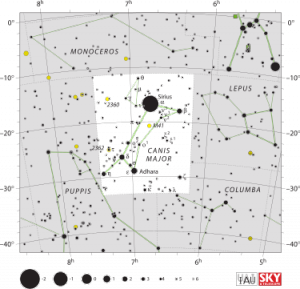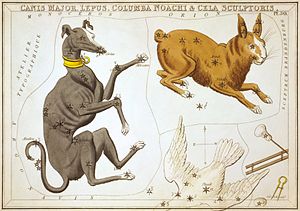Canis Major

Canis Major is a constellation in the southern celestial hemisphere. In the second century, it was included in Ptolemy's 48 constellations, and is counted among the 88 modern constellations. Its name is Latin for "greater dog" in contrast to Canis Minor, the "lesser dog"; both figures are commonly represented as following the constellation of Orion the hunter through the sky. The Milky Way passes through Canis Major and several open clusters lie within its borders, most notably M41. Canis Major contains Sirius, the brightest star in the night sky, known as the "dog star". It is bright because of its proximity to our Solar System. In contrast, the other bright stars of the constellation are stars of great distance and high luminosity. At magnitude 1.5, Epsilon Canis Majoris (Adhara) is the second brightest star of the constellation and the brightest source of extreme ultraviolet radiation in the night sky. Next in brightness are the yellow-white supergiant Delta (Wezen) at 1.8, the blue-white giant Beta (Mirzam) at 2.0, blue-white supergiants Eta (Aludra) at 2.4 and Omicron1 at 3.0, and white spectroscopic binary Zeta (Furud), also at 3.0. The red hypergiant VY Canis Majoris is one of the largest stars known, while the neutron star RX J0720.4-3125 has a radius of a mere 5 km.
Canis Major is a constellation in the Southern Hemisphere's summer (or northern hemisphere's winter) sky, bordered by Monoceros (which lies between it and Canis Minor) to the north, Puppis to the east and southeast, Columba to the southwest, and Lepus to the west.
The band of the Milky Way goes through Canis Major, with only patchy obscurement by interstellar dust clouds. It is bright in the northeastern corner of the constellation, as well as in a triangular area between Adhara, Wezen and Aludra, with many stars visible in binoculars. Canis Major boasts several open clusters. The only Messier object is Messier 41 (NGC 2287), an open cluster.[1]
History and mythology
In ancient Mesopotamia, Sirius, named KAK.SI.DI by the Babylonians, was seen as an arrow aiming towards Orion, while the southern stars of Canis Major and a part of Puppis were viewed as a bow, named BAN in the Three Stars Each tablets, dating to around 1100 BC. In the later compendium of Babylonian astronomy and astrology titled MUL.APIN, the arrow, Sirius, was also linked with the warrior Ninurta, and the bow with Ishtar, daughter of Enlil. Ninurta was linked to the later deity Marduk who was said to have slain the ocean goddess Tiamat with a great bow, and worshipped as the principal deity in Babylon. The Ancient Greeks replaced the bow and arrow depiction with that of a dog.

In Greek Mythology, Canis Major represented the dog Laelaps, a gift from Zeus to Europa; or sometimes the hound of Procris, Diana's nymph; or the one given by Aurora to Cephalus, so famed for its speed that Zeus elevated it to the sky. It was also considered to represent one of Orion's hunting dogs,[6] pursuing Lepus the Hare or helping Orion fight Taurus the Bull; and is referred to in this way by Aratos, Homer and Hesiod. The ancient Greeks refer only to one dog, but by Roman times, Canis Minor appears as Orion's second dog. Alternative names include Canis Sequens and Canis Alter. Canis Syrius was the name used in the 1521 Alfonsine tables. The Roman myth refers to Canis Major as Custos Europae, the dog guarding Europa but failing to prevent her abduction by Jupiter in the form of a bull, and as Janitor Lethaeus, "the watchdog". In medieval Arab astronomy, the constellation became Al Kalb al Akbar, "the Greater Dog", transcribed as Alcheleb Alachbar by 17th century writer Edmund Chilmead. Islamic scholar Abū Rayḥān al-Bīrūnī referred to Orion as Al Kalb al Jabbār, "the Dog of the Giant". Among the Merazig of Tunisia, shepherds note six constellations that mark the passage of the dry, hot season. One of them, called Merzem, includes the stars of Canis Major and Canis Minor and is the herald of two weeks of hot weather.[2]
Sirius Star
Since December's major portal opening, we have undergone sequential events that have radically shifted the Universal Geomantic Structure. This is the architecture linking celestial bodies, constellations, and stars with our planet. During the Easter Weekend, transmissions activated the planetary body to communicate with the intelligent living matrix of the Canis Major constellation and the Sirius Star System. This activated previously dormant or corrupted communication links and Ley Lines networks into the planetary body. These new links cannot be circumvented by Alien Machinery or their synthetic timelines. These Triad Communication Networks are analogous to dropping a new intergalactic wireless internet hook up from Sirius B and the massive Sirius Sun, into the planetary body. [3]
HGS Session References
HGS Sessions - Clearing Tara, Gaia, Cradle of Lyra- 3/12/2015 [4]HGS Sessions - Clearing Sexual Misery, Breeder Programs - 3/31/2015 [5]
References
- ↑ Canis Major
- ↑ Canis Major
- ↑ Single Soul Occupancy
- ↑ HGS Session
- ↑ HGS Session
Found in HGS Manual on Page 108 Found in HGS Manual on Page 115

